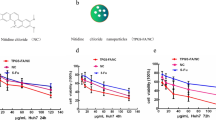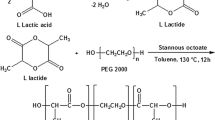Abstract
The aim of this study was to evaluate the potential of zoledronic acid (ZOL)-loaded lipidic nanoparticles (ZOL-NLCs) in enhancing the efficiency of paclitaxel (Pac) in the context of cytotoxicity, apoptosis, and invasiveness of HepG2 hepatocellular carcinoma cells. ZOL-NLCs were characterized in terms of zeta potential, particle size, and scanning electron microscope (SEM) as well as cell internalization. To measure the anti-proliferative effects of ZOL-NLCs, annexin-V/PI and MTT assays were employed. Real-time PCR and western blot analysis were performed to identify the molecular mechanisms underlying the apoptosis in response to the studied conditions. Furthermore, the transwell migration assay was applied to clarify the role of applied formulations on the invasiveness of HepG2 cells. Our results demonstrated that the optimized ZOL had an average particle size of 105 ± 6 nm with a nearly narrow size distribution. The IC50 values for ZOL and ZOL-NLCs were 90 ± 3.1 and 54.6 ± 2.4 µM, respectively. The population of apoptotic cells was increased from 17 ± 2% to 27 ± 4% (p < 0.05) in response to treatment with ZOL-NLCs. ZOL-loaded nanoparticles triggered the mRNA expression of Bax as pro-apoptotic marker and E-cadherin as epithelial one along with a decrease in mesenchymal marker, N-cadherin, and Bcl-xl as an anti-apoptotic marker in HepG2 cells. These outcomes were consistent with western blot analysis of protein expressions. Besides, ZOL-incorporated lipidic nanoparticles reduced the migration of HepG2 cells significantly. Our data suggest that the formulation of ZOL into lipidic nanoparticles can be considered a potential therapeutic approach that can enhance the efficacy of Pac chemotherapy.







Similar content being viewed by others
Data availability
Data is available as a supplementary file.
References
Bazzaz R, Bijanpour H, Pirouzpanah SM, Yaghmaei P, Rashtchizadeh N (2019) Adjuvant therapy with γ-tocopherol-induce apoptosis in HT-29 colon cancer via cyclin-dependent cell cycle arrest mechanism. J Biochem Mol Toxicol 33:e22399
Boissier S, Ferreras M, Peyruchaud O, Magnetto S, Ebetino FH, Colombel M, Delmas P, Delaissé J-M, Clézardin P (2000) Bisphosphonates inhibit breast and prostate carcinoma cell invasion, an early event in the formation of bone metastases. Can Res 60:2949–2954
Caraglia M, D’Alessandro AM, Marra M, Giuberti G, Vitale G, Viscomi C, Colao A, Del Prete S, Tagliaferri P, Tassone P (2004) The farnesyl transferase inhibitor R115777 (Zarnestra®) synergistically enhances growth inhibition and apoptosis induced on epidermoid cancer cells by Zoledronic acid (Zometa®) and Pamidronate. Oncogene 23:6900–6913
Chou T-C (2010) Drug combination studies and their synergy quantification using the Chou-Talalay method. Can Res 70:440–446
Craig AJ, Von Felden J, Garcia-Lezana T, Sarcognato S, Villanueva A (2020) Tumour evolution in hepatocellular carcinoma. Nat Rev Gastroenterol Hepatol 17:139–152
Danaei M, Dehghankhold M, Ataei S, Hasanzadeh Davarani F, Javanmard R, Dokhani A, Khorasani S, Mozafari M (2018) Impact of particle size and polydispersity index on the clinical applications of lipidic nanocarrier systems. Pharmaceutics 10:57
Estanqueiro M, Amaral MH, Conceição J, Lobo JMS (2015) Nanotechnological carriers for cancer chemotherapy: the state of the art. Colloids Surf, B 126:631–648
Fazil M, Baboota S, Sahni JK, Ameeduzzafar AJ (2015) Bisphosphonates: therapeutics potential and recent advances in drug delivery. Drug Delivery 22:1–9
Giordano S, Petrelli A (2008) From single-to multi-target drugs in cancer therapy: when aspecificity becomes an advantage. Curr Med Chem 15:422–432
Gnant M, Mlineritsch B, Schippinger W, Luschin-Ebengreuth G, Pöstlberger S, Menzel C, Jakesz R, Seifert M, Hubalek M, Bjelic-Radisic V (2009) Endocrine therapy plus zoledronic acid in premenopausal breast cancer. N Engl J Med 360:679–691
Gomaa AI, Khan SA, Toledano MB, Waked I, Taylor-Robinson SD (2008) Hepatocellular carcinoma: epidemiology, risk factors and pathogenesis. World J Gastroenterol: WJG 14:4300
Honda Y, Takahashi S, Zhang Y, Ono A, Murakami E, Shi N, Kawaoka T, Miki D, Tsuge M, Hiraga N (2015) The effects of bisphosphonate zoledronic acid in hepatocellular carcinoma, depending on mevalonate pathway. J Gastroenterol Hepatol 30:619–627
Kalkan H (2021) The program cell death (apoptosis) and the therapy of cancer. Regulation and Dysfunction of Apoptosis. IntechOpen
Kalyane D, Raval N, Maheshwari R, Tambe V, Kalia K, Tekade RK (2019) Employment of enhanced permeability and retention effect (EPR): nanoparticle-based precision tools for targeting of therapeutic and diagnostic agent in cancer. Mater Sci Eng, C 98:1252–1276
Kato T, Sato T, Yokoi K, Sekido Y (2017) E-cadherin expression is correlated with focal adhesion kinase inhibitor resistance in Merlin-negative malignant mesothelioma cells. Oncogene 36:5522–5531
Khaki-Khatibi F, Zeinali M, Ramezani B, Sabzichi M, Mohammadian J, Hamishehkar H (2020) Harnessing WYE-132 as an inhibitor of the mTOR signaling enriches the cytotoxicity effect of vinblastine in B16F10 melanoma cancer cells. Process Biochem 99:123–130
Li M, Bu X, Cai B, Liang P, Li K, Qu X, Shen L (2019) Biological role of metabolic reprogramming of cancer cells during epithelial-mesenchymal transition. Oncol Rep 41:727–741
Lin C, Xin S, Qin X, Li H, Lin L, You Y (2016) Zoledronic acid suppresses metastasis of esophageal squamous cell carcinoma cells through upregulating the tight junction protein occludin. Cytotechnology 68:1233–1241
Livak KJ, Schmittgen TD (2001) Analysis of relative gene expression data using real-time quantitative PCR and the 2− ΔΔCT method. Methods 25:402–408
Maroufi NF, Vahedian V, Mazrakhondi SAM, Kooti W, Khiavy HA, Bazzaz R, Ramezani F, Pirouzpanah SM, Ghorbani M, Akbarzadeh M (2020) Sensitization of MDA-MBA231 breast cancer cell to docetaxel by myricetin loaded into biocompatible lipid nanoparticles via sub-G1 cell cycle arrest mechanism. Naunyn Schmiedebergs Arch Pharmacol 393:1–11
Mohammadian J, Mahmoudi S, Pourmohammad P, Pirouzpanah M, Salehnia F, Maroufi NF, Samadi N, Sabzichi M (2020) Formulation of Stattic as STAT3 inhibitor in nanostructured lipid carriers (NLCs) enhances efficacy of doxorubicin in melanoma cancer cells. Naunyn Schmiedebergs Arch Pharmacol 393:2315–2323
Mortezaee K (2021) Organ tropism in solid tumor metastasis: an updated review. Future Oncol 17:1943–1961
Na T-Y, Schecterson L, Mendonsa AM, Gumbiner BM (2020) The functional activity of E-cadherin controls tumor cell metastasis at multiple steps. Proc Natl Acad Sci 117:5931–5937
Nel A, Ruoslahti E, Meng H (2017) New insights into “permeability” as in the enhanced permeability and retention effect of cancer nanotherapeutics. ACS Publications
Poonia N, Narang JK, Lather V, Beg S, Sharma T, Singh B, Pandita D (2019) Resveratrol loaded functionalized nanostructured lipid carriers for breast cancer targeting: systematic development, characterization and pharmacokinetic evaluation. Colloids Surf, B 181:756–766
Powers KW, Palazuelos M, Moudgil BM, Roberts SM (2007) Characterization of the size, shape, and state of dispersion of nanoparticles for toxicological studies. Nanotoxicology 1:42–51
Sabzichi M, Ramezani M, Mohammadian J, Ghorbani M, Mardomi A, Najafipour F, Mehdizadeh A (2019) The synergistic impact of quinacrine on cell cycle and anti-invasiveness behaviors of doxorubicin in MDA-MB-231 breast cancer cells. Process Biochem 81:175–181
Safa AR, Pollok KE (2011) Targeting the anti-apoptotic protein c-FLIP for cancer therapy. Cancers 3:1639–1671
Saghatelyan T, Tananyan A, Janoyan N, Tadevosyan A, Petrosyan H, Hovhannisyan A, Hayrapetyan L, Arustamyan M, Arnhold J, Rotmann A-R (2020) Efficacy and safety of curcumin in combination with paclitaxel in patients with advanced, metastatic breast cancer: a comparative, randomized, double-blind, placebo-controlled clinical trial. Phytomedicine 70:153218
Schech AJ, Kazi AA, Gilani RA, Brodie AH (2013) Zoledronic acid reverses the epithelial–mesenchymal transition and inhibits self-renewal of breast cancer cells through inactivation of NF-κB. Mol Cancer Ther 12:1356–1366
Stemmler MP (2008) Cadherins in development and cancer. Mol BioSyst 4:835–850
Suzuki R, Omata D, Oda Y, Unga J, Negishi Y, Maruyama K (2016) Cancer therapy with nanotechnology-based drug delivery systems: applications and challenges of liposome technologies for advanced cancer therapy. Nanomaterials in Pharmacology. Springer 457–482
Talluri SV, Kuppusamy G, Karri VVSR, Tummala S, Madhunapantula SV (2016) Lipid-based nanocarriers for breast cancer treatment–comprehensive review. Drug Delivery 23:1291–1305
Tassone P, Tagliaferri P, Viscomi C, Palmieri C, Caraglia M, D’Alessandro A, Galea E, Goel A, Abbruzzese A, Boland C (2003) Zoledronic acid induces antiproliferative and apoptotic effects in human pancreatic cancer cells in vitro. Br J Cancer 88:1971–1978
Tupal A, Sabzichi M, Bazzaz R, Fathi Maroufi N, Mohammadi M, Pirouzpanah SM, Ramezani F (2020) Application of ɑ-tocotrienol-loaded biocompatible precirol in attenuation of doxorubicin dose-dependent behavior in HUH-7 hepatocarcinoma cell line. Nutr Cancer 72:653–661
Varshosaz J, Davoudi MA, Rasoul-Amini S (2018) Docetaxel-loaded nanostructured lipid carriers functionalized with trastuzumab (Herceptin) for HER2-positive breast cancer cells. J Liposome Res 28:285–295
Virtanen SS, Ishizu T, Sandholm JA, Löyttyniemi E, Väänänen HK, Tuomela JM, Härkönen PL (2018) Alendronate-induced disruption of actin cytoskeleton and inhibition of migration/invasion are associated with cofilin downregulation in PC-3 prostate cancer cells. Oncotarget 9:32593
Yang J, Antin P, Berx G, Blanpain C, Brabletz T, Bronner M, Campbell K, Cano A, Casanova J, Christofori G (2020a) Guidelines and definitions for research on epithelial–mesenchymal transition. Nat Rev Mol Cell Biol 21:341–352
Yang X, Gao Y, Liu Q, Wan L, Liu H, Bian W, Du Y, Huang C (2020b) Zoledronic acid re‑sensitises gefitinib‑resistant lung cancer cells by inhibiting the JAK/STAT3 signalling pathway and reversing epithelial‑mesenchymal transition. Oncology Reports
Yu W, Yang L, Li T, Zhang Y (2019) Cadherin signaling in cancer: its functions and role as a therapeutic target. Front Oncol 9:989
Funding
This project was accomplished by a grant from the Liver and Gastrointestinal Disease Research Center, Tabriz University of Medical Sciences, Tabriz, Iran.
Author information
Authors and Affiliations
Contributions
M.S. and O.O. involved in the procedures of experiments. J.M., B.R., and M.H. had contribution in manuscript writing. M.R., M.G., and A.M. involved in performance molecular experiments and data analysis and interpretation. F.R. had the main contribution in conception, design, and manuscript editing as well as financial support. All authors read and approved the manuscript, and all data were generated in-house and that no paper mill was used.
Corresponding author
Ethics declarations
Ethics approval
Not applicable.
Consent to participate
Not applicable.
Consent for publication
Not applicable.
Conflict of interest
The authors declare no competing interests.
Additional information
Publisher's note
Springer Nature remains neutral with regard to jurisdictional claims in published maps and institutional affiliations.
Mehdi Sabzichi1 and Omolbanin Oladpour contributed equally to this work.
Rights and permissions
About this article
Cite this article
Sabzichi, M., Oladpour, O., Mohammadian, J. et al. Zoledronic acid-loaded lipidic nanoparticles enhance apoptosis and attenuate invasiveness by inhibiting epithelial to mesenchymal transition (EMT) in HepG2 cancer cells. Naunyn-Schmiedeberg's Arch Pharmacol 394, 2429–2439 (2021). https://doi.org/10.1007/s00210-021-02164-5
Received:
Accepted:
Published:
Issue Date:
DOI: https://doi.org/10.1007/s00210-021-02164-5




